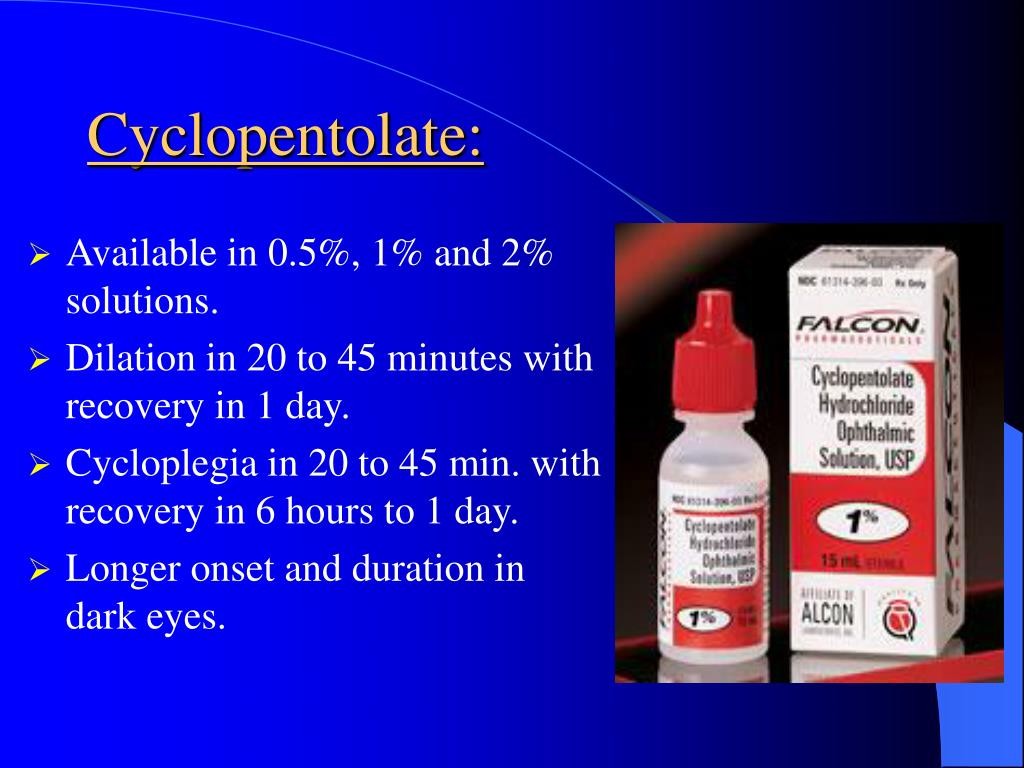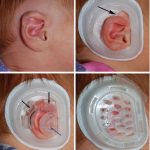
Contents
cyclopentolate
Cyclopentolate temporarily paralyzes the eye muscles that enable pupil widening (mydriasis), narrowing (miosis), and focusing the vision for near and far objects (accommodation). It is also used off-label to relieve pain from uveitis, inflammation of the middle layer of the eye called the uvea.
Cyclopentolate is an anticholinergic agent that blocks acetylcholine activity, a chemical secreted by nerve cells in neuromuscular junctions to make muscles contract. It achieves pupil dilation (mydriasis) by:
- Paralyzing the sphincter muscle that contracts with bright light and dilates in low light
- Paralyzing the ciliary muscle that adjusts lens shape and thickness, enabling eye accommodation
Warnings
- Do not use in patients with hypersensitivity to cyclopentolate or any of the components in the solution.
- Remove contact lenses before administration and wait for 15 minutes before reinsertion.
- Avoid letting the dropper tip touch any surface to prevent contamination of the solution.
- Cyclopentolate may cause a transient burning sensation in the eye.
- Cyclopentolate may cause a transient increase in intraocular pressure, especially in elderly patients. Use with caution in patients with narrow-angle glaucoma.
What should I avoid after pupil dilation?
- Avoid engaging in hazardous activities while under the effects of the drug.
- Protect the eyes from bright light while the pupils remain dilated.
- Infants may experience feeding intolerance after administration of ophthalmic cyclopentolate. Withhold feeding for 4 hours.
- Cyclopentolate may have central nervous system and cardiopulmonary effects, especially in young children and with high-strength solutions. Exercise caution.
What are the side effects of cyclopentolate?
Common side effects of cyclopentolate include:
- Burning sensation in the eye
- Blurred vision
- Eye focusing difficulty (accommodation disturbance)
- Increase in intraocular pressure
- Light intolerance
- Inflammation of the conjunctiva (conjunctivitis)
- Burning sensation of the skin
- Hypersensitivity reaction
- Drowsiness
- Rapid heart rate (tachycardia)
- Hyperreactive response in Down’s syndrome children
- Hyperactivity
- Impairment of coordination and balance (ataxia)
- Incoherent speech
- Restlessness
- Hallucination
- Psychosis
- Seizure
Call your doctor immediately if you experience any of the following symptoms or serious side effects while using this drug:
- Serious heart symptoms include fast or pounding heartbeats, fluttering in your chest, shortness of breath, and sudden dizziness;
- Severe headache, confusion, slurred speech, severe weakness, vomiting, loss of coordination, feeling unsteady;
- Severe nervous system reaction with very stiff muscles, high fever, sweating, confusion, fast or uneven heartbeats, tremors, and feeling like you might pass out; or
- Serious eye symptoms include blurred vision, tunnel vision, eye pain or swelling, or seeing halos around lights.
This is not a complete list of all side effects or adverse reactions that may occur. Call your doctor for medical advice about serious side effects or adverse reactions. You may also report side effects or health problems to the FDA at 1-800-FDA-1088.
What are the dosages of cyclopentolate?
Solution
Adult:
Mydriasis/Cycloplegia Diagnosis
- 1-2 drops of 1% solution in the eye
- May repeat in 5 minutes as needed
- Cycloplegia and mydriasis may last for 24 hours
- Use 2% in a heavily pigmented iris
Pediatric:
Mydriasis/Cycloplegia
- 1-2 drops of 0.5%, 1%, or 2% solution in eye
- May repeat 5 minutes later by a second application of 0.5% or 1% solution if necessary
Overdose
- Cyclopentolate overdose in the eye can cause persistent pupil dilation for several hours, which generally resolves on its own. Ocular overdose can be treated by flushing the eyes with clean water.
- Systemic absorption from ocular overdose can cause dilated pupils, disorientation, visual hallucination, behavior disturbances, and impairment of balance, coordination, and speech (ataxia).
- Oral ingestion of cyclopentolate eye solution can cause dizziness, rapid heart rate (tachycardia), drowsiness, dry mouth, uncoordinated movements, and behavioral disturbances.
- Adverse effects from systemic absorption usually resolve within a few hours. Severe systemic effects from oral overdose may be treated by inducing vomiting, performing gastric lavage, and if required, administration of physostigmine, a drug that reverses the effects of cyclopentolate.
What drugs interact with cyclopentolate?
Inform your doctor of all medications you are currently taking to avoid possible drug interactions. Never begin taking, suddenly discontinue, or change the dosage of any medication without your doctor’s recommendation.
- Severe interactions of cyclopentolate include:
- aclidinium
- cimetropium
- eluxadoline
- glycopyrrolate oral inhalation
- glycopyrronium topical
- ipratropium
- levosulpiride
- oxatomide
- potassium chloride
- potassium citrate
- pramlintide
- revefenacin
- tiotropium
- umeclidinium
- clozapine
- secretin
The above drug interactions are not exhaustive. For more information, visit the RxList Drug Interaction Checker. Inform your healthcare provider about all prescription and over-the-counter medications you use.
Pregnancy and breastfeeding
- No animal reproductive studies or well-controlled human trials have been conducted on cyclopentolate use during pregnancy. Use in pregnant women only if clearly needed.
- Caution is advised in nursing mothers as it is unknown if cyclopentolate is excreted in breast milk.
What else should I know about cyclopentolate?
- Follow your doctor’s instructions exactly if you use cyclopentolate for uveitis.
- Avoid letting the dropper touch any surface.
- Avoid the solution coming into contact with the mouth. Wash hands thoroughly after administration.
- Avoid driving or operating heavy machinery while the eyes are dilated.
- Protect your eyes from bright lights while the eyes are dilated.
- Store cyclopentolate safely out of reach of children.
- In case of ocular overdose, wash the eyes with water and consult with your ophthalmologist if symptoms persist.
- In case of oral overdose, seek medical help or contact Poison Control.
By clicking Submit, I agree to the MedicineNet’s Terms & Conditions & Privacy Policy and understand that I may opt out of MedicineNet’s subscriptions at any time.
Summary
Cyclopentolate is an ophthalmic solution used to dilate the pupils for eye examination and diagnostic purposes. Common side effects include burning sensation in the eye, blurred vision, eye focusing difficulty, increase in intraocular pressure, light intolerance, inflammation of the conjunctiva, burning sensation of the skin, hypersensitivity reaction, drowsiness, rapid heart rate, hyperreactive response in Down’s syndrome children, hyperactivity, impairment of coordination and balance, incoherent speech, restlessness, hallucination, psychosis, and seizure.


